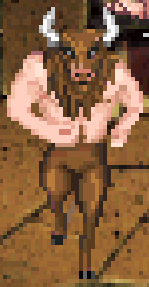Quest for Glory is a fucking awesome RPG series. It has aged wonderfully. The only weak link is 3, because they fucked with the formula. And 5, but that's a different story.
3 was kind of a last minute addition to the series.
This is what the creators originally had in mind: A game of four based on the four classical elements and the four seasons, with each game's theme, purpose and setting based around that idea:
Quest for Glory: So You Want to Be a Hero: North/Earth/Spring/Germanic
Quest for Glory II: Trial by Fire South Fire/Summer/Middle Eastern
Quest for Glory IV: Shadows of Darkness East/Air/Fall/Slavic
Quest for Glory V: Dragon Fire West/Water/Winter
However, when Shadows of Darkness was designed, it was thought that it would be too difficult for the hero to go straight from Shapeir to Mordavia and defeat the Dark One. To solve the problem, a new game, Wages of War, was inserted into the canon, and caused a renumbering of the series. Evidence for this can be found in the end of Trial by Fire: the player is told that the next game will be Shadows of Darkness and a fanged vampiric moon is shown, to hint at the next game's theme.
They talked about it in the Fall 1992 issue of Sierra's InterAction magazine:
"When we developed the concept for the series," explained Corey, "we wanted some unifying themes for the story. We worked with the four seasons, the four basic elements – Earth, Air, Fire, and Water – and the four cardinal points of the compass. We planned to create four games to follow these elements.
"The first game – So You Want to be a Hero – is springtime and Earth and set in medieval Germany in the North. The second game – Trial by Fire – was the element of Fire, in the summer, and set in the South, in Arabia."
"The original third chapter," added Lori, "was to be Shadows of Darkness, set in Transylvania – the East – and in the Fall, using Air as the central element."
Somewhere between finishing Trial by Fire and cranking up the design process for Shadows of Darkness, the husband-and-wife team realized a fifth chapter would have to be added to bridge the games. That chapter became Wages of War.
The concept of seasons in the games represents the maturation of the Hero as he moves from story to story. It's a critical component in a series that – from the very beginning – was designed to be a defined quartet of stories, representing an overall saga with a distinct beginning, middle, and end.
"One of the unifying themes," explained Corey, "is the growth of your character, going from being an adolescent Hero in the first game to being a young man in the second. You're strong and confident..."
"The third game," continued Lori, "was to show you as a master of your profession, with the fourth depicting you at the mature peek of your powers."
In the first episode, the player is a new graduate of the Famous Adventurer's Correspondence School, ready to venture out into the springtime of his career and build a rep. It's a light-hearted, exhilarating journey into the unknown that can be replayed three times with three distinct outlooks at puzzle-solving.
In the second chapter – Trial by Fire – the Hero enters the summer of his experience, facing more difficult challenges with more highly-developed skills. While the episode is more serious and dangerous than its predecessor, it retains the enchanting mixture of fantasy, challenge, and humor that made the first game a hit with so many fans.
Of all the reasons Lori and Corey found for creating a bridge between Trial by Fire and Shadows of Darkenss, the most compelling was the feeling that the Hero character simply hadn't matured enough to face the very grim challenges awaiting him in Transylvania.
"In terms of role-playing aspects," said Corey, "Shadows of Darkness is going to be a very difficult game. You'll have very tough opposition from the very beginning of the game."
"Also," said Lori, "you'll be very much alone. In Trial by Fire you had a lot of friends to help you. You always had a place to go back to rest. You always had a place of safety until the very end of the game. Once you get into Shadows of Darkness, you're not going to have any sanctuary. You won't be able to trust anyone, because nobody will trust you.
"Wages of War is the bridge," she continues. "You start with people you know to help you along in the beginning. But when push comes to shove, you're the one who's on his own, who has to solve the ultimate mystery. As you go along, just when you think you're all alone, your allies come back to you, but you have to face the final challenge by yourself."
— Lori and Corey Cole























![The Year of Incline [2014] Codex 2014](/forums/smiles/campaign_tags/campaign_incline2014.png)








 Real men play the original EGA version with text parser.
Real men play the original EGA version with text parser.

